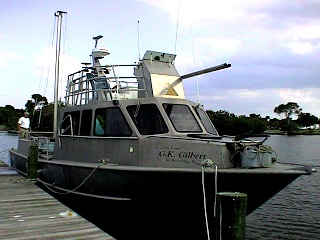A USGS Marine and Coastal Studies Skill Training Module
1B. Vibracore preparation
Vibracore Diagram
The Vibracore assembly and support components are shown on the stern deck in the diagram. The components are discussed in detail in the video segments with key points noted below.

Guy lines
Vertical beam
Blocks
Hand
lines
1B1. General Components - Video 1B1.
* Tool for the vibracore process include:
- The rigging
- The vibration system
- The crane
* The rigging is composed of:
- a base
(usually made from galvanized steel to
provide weight for stability),
- an aluminum "I" beam that the vibrator
travels up and down,
- guys to support the beam.
* The "I" beam length is variable depending on coring requirements and could be
from 10 feet to 20 feet.
* The "I" beam may have holes to stop the vibrator from traveling fully up to
the top. The top of the beam has a wire guide to keep the rigging secure.
* The top of the beam has an aluminum box which houses a potentiometer for measuring the
length of the barrel in the sediment.
1B2. Pneumatic Components - Video 1B2.
* The vibration system is composed of two air compressors delivering 35 square feet per
minute at 100 psi each.
* The compressor air lines link to an in-line system to control the flow of air to the
vibrator.
* An oil device is included in the system to distribute oil to the vibrator head during
coring. The lubricant used is a 20 - 30 weight air tube oil. There is an on-board
container to catch the used oil from the system.
* An external port is provided for attaching air driven tools.
* An external exhaust is provide to reduce the pressure in the air line if required.
* An in-line valve is provide to start or stop the flow of air in the line if required.
1B3. Vibrator Components - Video 1B3.
* The vibrator head consists of a stainless steel sleeve, a stainless steel piston, an
air intake port and an air exhaust port.
* The vibrator sits in a cradle attached to the "I" beam. The cradle has a cable
attached used to pull the core out of the sediment.
* The core barrel is attached to the cradle using a stainless steel nipple which has a
float valve (ball valve) inside.
* The barrel is guided into the sediment through a kick stand with a circle cut out.
1B4. Necessary Tools - Video 1B4.
* Some of the working tools necessary during a coring operation include:
- clamp for attaching the barrel to the nipple
- a wrench to attach and detach the clamp
- a pipe cutter or a hack saw
1B5. Core Barrel Preparation - Video 1B5.
* To facilitate the installation of the barrel onto the nipple of the vibrator it is
necessary to cut four vertical slots in the end of the barrel using a hack saw. Note: the
slots should not be longer than the length of the nipple to prevent air from entering the
core and causing the loss of internal pressure when extracting the core from the sediment.
* When installing the barrel to the nipple, be sure that the clamp is on straight relative
to the barrel to ensure a snug fit.
* Take care not to get the clamp caught in the four slots which will prevent the barrel
from attaching tightly to the nipple. THIS WILL CAUSE YOU TO LOSE THE BARREL DURING
RECOVERY.

First |
Previous |
Next |
Credits |
Index |
Exit |